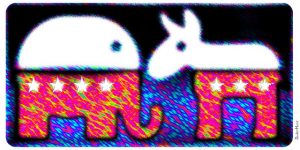
Over the last week I have seen one red, gray and blue graphic more than any other. It seeks to tell the complex story of pastoral political affiliation in the United States in a single image.
The widely shared graphic comes from Kevin Quealy’s June 12 New York Times article “Your Rabbi? Probably a Democrat. Your Baptist Pastor? Probably a Republican. Your Priest? Who Knows.” Quealy’s article reports on the most ambitious research of its kind, which was undertaken by Eitan D. Hersh and Gabrielle Malina (the full text of the draft of their academic article can be read here).
Most Likely A Democrat
The religious traditions in which a leader is most likely to be a Democrat based on their party affiliation are
- Reform Judaism – 80%+
- African Methodist Episcopal (AME) – 75%+
- Unitarian – 70%+
- Conservative Judaism – 70-%+
- United Church of Christ – 60%+
Most Likely a Republican
The religious traditions in which a leader is most likely to be a Republican based on their party affiliation are
- Brethren – 75%+
- The Evangelical Church – 75%
- Churches of God, General Conference (CGGC) – 70%+
- Fundamental Baptist – 70%+
- Independent Baptist – 70%+
Digging Deeper
Eitan D. Hersh and Gabrielle Malina explain their interest in conducting this groundbreaking research:
Our interest in the politics of pastors rests on the assumption that pastors have influence over a substantial share of the American public. Prior work supports this assumption, demonstrating that pastors are aware of their power as moral, spiritual, and political leaders and that this power has real consequences both for congregants’ political attitudes as well as their connections with local government officials (Beatty and Walter 1989; Djupe and Gilbert 2001; Guth 1997; Lincoln and Mamiya 1990; Olson 2000) (p.3).
And note that
Party affiliation is a simple proxy for a pastor and congregant’s political attitudes, but it is a powerful one. In recent years, about 90% of partisans vote for their party’s candidates for nearly all offices. Partisanship is also a strong predictor of issue positions (p.12).
Hersh and Malina found that in liberal religious traditions, clergy tended to be even more liberal than their congregants. Additionally, they found “unmistakeable support” for
. . . the hypothesis that denomination is a powerful proxy for the partisanship of pastors. Both within and between faith traditions, American clergy are significantly diverse in their political affiliations, suggesting that different religious denominations have profoundly different orientations toward politics; such differences are likely due to theological traditions and orthodoxy, as well as denomination-specific norms surrounding politics and political behavior (p.28)
So What?
Quealy succinctly states a key finding of Hersh and Melina’s research:
pastors are even more politically divided than the congregants in their denomination: Leaders of more liberal denominations tend to be even more likely to be registered as Democrats, and those of more conservative denominations even more likely to be registered as Republicans.
Personally, this did not come as a surprise. I have long known the general idea was true, even without significant statistical evidence to state the claim.
I returned to the rank order of the religious traditions with the highest percentage of pastors registered as Democrats. I removed the non-Christian religions from the chart to determine the religious traditions in which a leader is most likely to be a Democrat based on their party affiliation:
- African Methodist Episcopal (AME) – 75%+
- United Church of Christ – 60%+
- Episcopal – 60%
- Evangelical Lutheran Church in America (ELCA) – 55%+
- Disciples of Christ – 55%+
- Presbyterian – 50%+
This list became very personal. While I have no experience in the AME, I have found my religious home in the remaining traditions listed. I served three congregations affiliated with the United Church of Christ, was married in the Episcopal church, served one ELCA congregation, served two ELCA congregations, and served two PCUSA (Presbyterian Church, USA) congregations. And, I am presently a member of one the largest congregations affiliated with the United Church of Christ.
- Guess what percentage of pastors in your religious tradition are registered as a Democrat and what percentage are registered as Republican then see how accurate your guesses were using the chart provided at this link,
- Does your own political affiliation align with the dominant affiliation of leaders within your religious tradition? If so, how has this alignment enriched your theological understanding of contemporary political issues? If not, how often do you find yourself frustrated by messages shared by your pastor or your denominational body?
- Offer your thoughts on why this data matters at the present moment in American history. Feel free to draw on your personal experiences as a pastor or as someone who has heard pastors preach and teach in our increasingly politically fragmented society.